Climate in Medellin: Among The Best in The World ?
By Kaveh Paymayesh
After travelling many parts of the world for 27 years, I argue that the climate in Medellin is as close to perfect as it gets.
In this article we cover:
- What climate does Medellin have?
- Average temperature and precipitation
- The effect of elevation
- What an ‘average’ day feels like
- Microclimates
- Is the rain that bad?
- The ‘rainy’ seasons
- Are there other cities with a similar climate?
And much more!
What climate does Medellin have?
The Köppen climate classification lists Medellin as having a Tropical Rainforest Climate (Af).
An Af climate means that rainfall and temperatures remain high throughout the year, with little fluctuation. Cartagena does not have this climate as it has a dry season from December to March.
The closer a place is to the equator, the more likely it is to have the Af climate type. In Medellin, you will not experience the 4-seasons that you may be used to. The hour of sunset is consistent year-round.
In short, an Af climate is hot and wet year-long, with sunrises and sunsets which occur at roughly the same time.
Medellin’s climate, however, is not too hot. This is thanks to its altitude of 1,495m+ above sea level. Temperature is affected by elevation and with every 100-metre increase, the average temperature decreases by 0.7°C.
Although it CAN get hot, Medellin is cooler than other tropical cities closer to sea level. We can thank the geological phenomenon of the Andes for this.
Medellin enjoys the benefits that come with a tropical climate while avoiding many of its drawbacks – chiefly heat and humidity.
What is the average temperature in Medellin and how much does it rain?
The graph above shows us that:
- the average high temperature is 27°C
- the average low temperature is 16 °C.
This means that on any given day of the year, from 12pm – 3pm, the temperature will be around 27°C and fall to around 16°C during the early hours of the morning.
This gives us an overall average of 21.5°C or 69.8°F. Throw into the mix daily showers and can you see what gives Medellin its nickname as the “City of Eternal Spring”?
And yes, it does rain a lot in Medellin – but don’t get disheartened. The city alone (not including the whole valley) averages 2958mm of precipitation each year. This number has been higher in recent years due to the climatic phenomena known as El Niño and La Niña. More on that later though.
January is supposidely the driest month yet still experiences 147mm of rainfall. This dispels the myth that Medellin has a ‘dry’ season. I prefer the terms: ‘wet and wetter’ season.
You may notice locals refer to winter and summer periods in Medellin. In reality, they are referring to short-term patterns; whether that week was particularly dry or wet.
The wettest month is generally in April with 347mm of precipitation.
My experiences do not line up with what the data suggests. January of 2023 was very rainy with afternoon showers behaving like clockwork. April has had fewer rainy afternoons than January so take these figures with a pinch of salt.
The weather in Medellin is unpredictable!
Medellin's climate is blessed by its elevation
Medellin is widely deemed to have the best climate in the country. In my experience, people like to visit hotter cities but prefer to live in Medellin. All is well and good when on holiday but have you tried working or being productive in oppressively hot places? It’s no coincidence that the hottest places in Colombia are among the least productive.
Medellin’s climate is hard to come by. An altitude of 1,500m in the tropics appears to achieve the Goldilocks Effect. Much higher and it starts getting chilly at night (like in Colombia’s capital), much lower and things like humidity and heat become an issue.
At around 1,500m there is also a freshness that is felt within the valley. Shade feels great on a hot day in a way that somewhere like Cartagena does not. Additionally, cool mountain breezes will sometimes sweep through the valley and help disperse the city’s pollution. On hot days when the air feels still – so too is the pollution.
What does the average day’s weather feel like in Medellin?
Amazing in short. No two days are completely the same due to the unpredictability of the tropics.
Do NOT rely on what weather forecasts say. If you type in ‘Medellin weather’ – you’ll probably find something like this:
Rain, rain and more rain… Looks miserable, doesn’t it? Don’t despair. Medellin’s climate can only be fully grasped with boots on the ground.
One thing certain about the weather in Medellin is that the temperature will never fall below 15°C or go above 32°C.
Mornings can be cool and cloudy. Depending on your prefences, you may be more comfortable with trousers/pants and a light fleece. Shorts and a t-shirt are ideal for most however. That’s what you’ll see most tourists happily wearing.
It is rare for it to rain in the mornings but the air does feel fresh and moist.
As the morning advances, the clouds and mist are pierced by strong rays of tropical heat from the sun. The sun feels strong but fortunately in Medellin there are tree canopies everywhere. The shade offers plenty of relief and means that you’re usually never exposed to powerful UVs for too long. Dipping in and out of the shade throughout Medellin’s leafy streets is something that always brightens up my day.
Don’t forego the sunscreen though. Colombia, and especially Medellin, experience some of the highest UV indexes in the world. Medellin’s proximity to the equator and increased elevation mean that the UV rays take much less time to arrive from the sun. Watch out for your skin – even when it feels cool.
Medellin manages to hold on to its higher temperatures until the sun begins to set. The sunset generally begins around 5:15pm and will be fully dark by 6:30pm. Sunrise begins early, roughly at 5:30am. This gives each day an average of 12h 50m of sunlight.
Unlike what you might expect in a semi-arid climate, Medellin’s skies are anything but monotonous with clouds constantly forming and dissipating. It can be quite the spectacle and provide for some beautiful vistas.
Afternoon rain is typical but doesn’t tend to last too long. Heavy downpours will quickly rip through the valley, only to then be sunny again minutes later.
Overcast days are also not a rare occurrence. The good news you won’t have to wait too long to see sunshine again. Nothing like London in that regard.
There are many microclimates to discover in Medellin
The Aburra Valley consists not only of Medellin but all of its surrounding municipalities. They are often and incorrectly confused with the city itself. These separate municipalities include Envigado, Bello, Sabaneta, Itagüí, Caldas, Copacabana, La Estrella, Giradota & Barbosa.
Together they make up the Greater Metropolitan Area of Medellin. Within the Aburra Valley you’ll find the climate differs depending on where you go.
Neighbourhoods like Laureles and El Centro sit within the basin of the valley at 1,495m above sea level. They are warmer than the areas up in the mountains. In the upper reaches of Envigado and El Poblado, the temperature is around 2-5 °C cooler than areas within the pit of the valley.
We can see this by looking at the forecast for two different parts of town.
Mirador de las Palmas and El Centro are less than 20 minutes from each other by car. Look how much the weather can change.
Las Palmas is 2,400m above sea level – that’s 1,000m more than El Centro. The temperature difference is 2°C.
At night, these differences become more noticable. Up in the fringes of the valley, you’ll probably want a fleece or extra layer as it can get chilly.
Altitude is not the only factor that results in these microclimates. The heat island effect, pollution and congestion can all exacerbate the heat. El Centro suffers particularly in this regard and temperatures can easily climb to 32°C.
Medellin is aware of this problem and recently implemented an award winning strategy to contend with the heat.
By strategically planting trees and vegetation throughout the city, particularly in areas affected by pollution, the city has been able to reduce its average temperature by up to 5°C. This move is known as the Green Corridors Project. You can read more here.
These local climates add another dynamic when deciding where to settle down. Cooler vs warmer?
Do you need an umbrella in Medellin? Is the rain really that bad?
An umbrella wouldn’t go a miss but NO – the rain isn’t as bad as you may think…
You might think of London as a rainy city, right? Well, in Medellin it rains 4x more than in London – and that’s not including the separate municipalities such as Envigado. Don’t let that ring the panic alarms though. That figure alone is misleading.
Even though it rains a lot more in Medellin, the nature and pattern of precipitation are completely different. London averages 1,400 hours of annual sunlight while in Medellin this number is 1,850.
In London, like in other temperate regions, rainfall tends to be prolonged. It falls slowly, drop by drop, lasting what feels like days at a time. Grey and gloomy…
That’s NOT the case in Medellin. Rainfall tends to be sharp, with blazing storms ripping through the valley before giving way to the sun again. Furthermore, rain typically falls in the afternoon, night or early morning. It also doesn’t usually last long (an hour or less). So no, even though it rains a lot in Medellin, it is not very disruptive. You won’t need to tentatively check the weather forecast for that weekend BBQ.
However, when it rains in Medellin, it pours! That means you’ll want to find cover, pronto. It’s a spectacle to watch the streets and hills turn into rivers – sometimes this happens in minutes.

Medellin averages somewhere between 2,400 mm – 3,000 mm of annual precipation. Compare that to London’s modest 600 mm and it would be easy to believe that this is really the ‘City of Eternal Rain’. But it’s not.
As mentioned, local weather forecasts don’t help either. They are unable to keep up with the pace of the tropical atmosphere and instead provide a conservative prediction – rain!
Fortunately, the reality on the ground (or sky) is very different. Don’t be deterred by what the forecast tells you, nor by certain figures (such as annual precipitation).
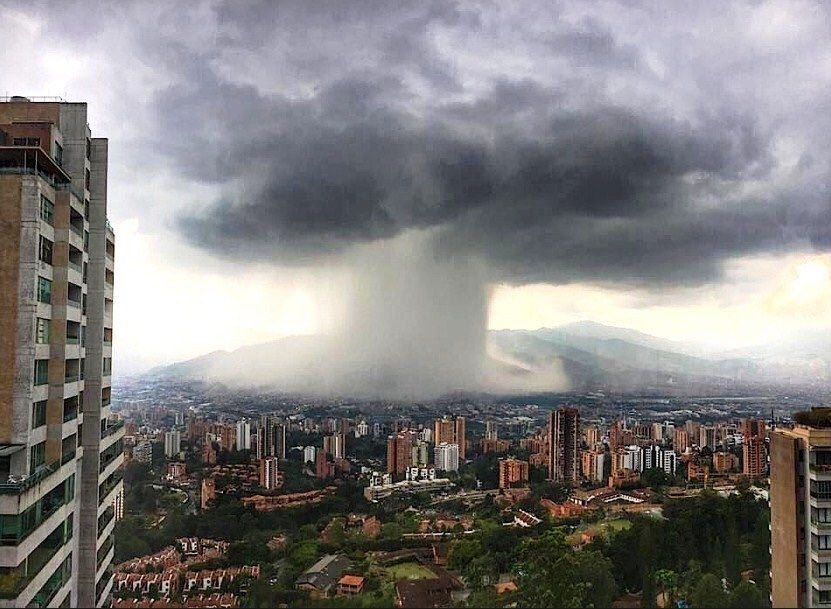
When are the 'rainy' seasons in Medellin?
Remember, the concept of dry and wet seasons in Medellin are a bit deceiving.
In my personal experience of living here, the climate is simply too tropical and unpredictable. Each year has been different.
Regardless, according to climate reports:
- the driest months typically stretch from December to February.
- June to August is another relatively dry period.
Even during the wetter months, it is normal that the majority of the day will be sunny or overcast. That’s why it can be hard to discern the rainy seasons as they, for the most part, feel like business as usual. It just may be the case that the afternoon showers begin behaving like clockwork.
Another phenomenon that you’ll observe in Medellin is how much the weather can vary depending on where you are. For example, it is normal for there to a thunderstorm on one side of the valley whilst the sun is shining in another…
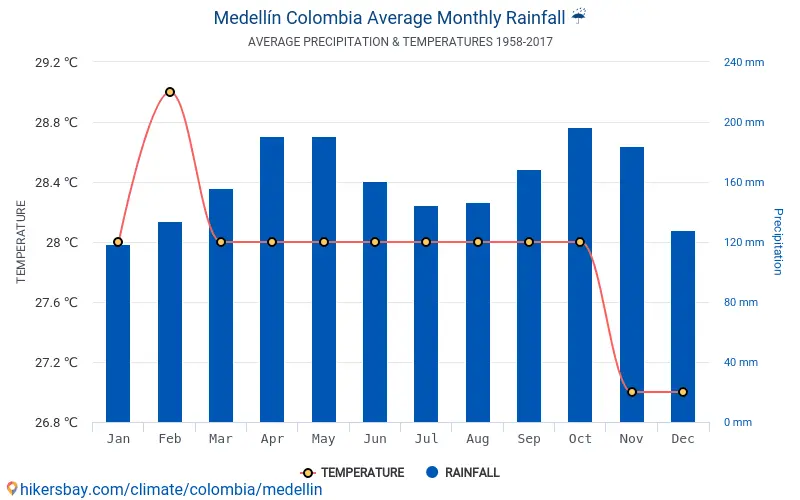
Does it really rain more in the south than in the north?
When I first arrived to Medellin, I was in disbelief when locals would tell me that it rains more in the southern side of the valley. It turns out that there is truth to this.
Despite urban legends and theories, there are indeed technical explanations for the climatic phenomenon of the south:
1.) In the south, the two opposing (eastern & western) slopes of the valley are very narrow. This generates multiple winds going up and down, working like a bottleneck. These atypical conditions produce a large amount of lightning and clouds, also known as systems.
2.) There are also local systems occuring in Rionegro (outside of the valley). Winds subsequently transport them to the southern side of the Aburra Valley. They may not always reach the more northern parts of the valley though.
3.) Biodiversity – rainforests generate their own rain and that is also the case here. The southern side of the valley is where the majority of the ecological reserves are (in Envigado, Sabaneta, La Estrella etc.) and so this creates its own (wetter) microclimate.

Are there other cities with a climate like Medellin's?
After discovering how agreeable Medellin’s climate is, many wonder if it is possible to find elsewhere in the world?
In truth, there are very FEW places which achieve this Goldilock Effect. The reason is that you need to find somewhere:
- In the tropics (for year-round consistency)
- Somewhere approximately 1,500-2,000m above sea level.
There are other cities in Colombia that satisfy this criteria:
- 1.) Bucaramanga – The City of Parks (959m above sea level)
Bucaramanga is Colombia’s 9th most populous city, has the lowest national rate of unemployment and contains over 160 parks – giving its nickname of the “City of Parks”. Like Medellin, it is also very green and home to friendly locals. The locals are NOT Paisas.
Bucaramanga experiences average highs of 78°F and average lowers of 67°F. It’s slightly warmer than Medellin but the weather is consistent year-round. It is slightly lower in altitude than the ideal 1,500m but for one reason another, is not too hot.
- 2.) Pereira – 1,411m above sea level.
Pereira is located within Colombia’s diverse Coffee Axis. Much of the area, for its beauty and abundance of coffee, is a UNESCO World Heritage Sight. The population is over 700,000 and just like in Medellin, the people here are Paisas. Very hospitable, friendly and beautiful.
The average high is 80°F and average low is 63°F.
Again, the weather is consistent year-round and very similar to Medellin’s (but ever so slightly warmer).
Is the climate in Medellin 'perfect'?
For me and millions of others – yes. The climate in Medellin is close to perfection. If however you seek 4 true seasons, then no.
If you want the guarantee of warm weather, year-round, yes.
If you absolutely hate the sight of rain and prefer arid/semi arid climates – no.
In short, Medellin’s climate is close to perfection because sun, warmth, biodiversity and vitamin D are always guaranteed, regardless of whether it is January or July. Although rain can be a bummer, remember that it is not as disruptive as it is in Ohio, London, New York, etc. This rain also creates lush vegetation; shade (which you’ll be needing).
Remember that thanks to the surrounding hills of the valley, you can fine-tune the kind of climate you want to experience. Hills = cooler weather, the basin = warmer.
This brings us to our final point – Medellin suffers from the effects of climate change. Since coming here, I have observed everything from droughts to flooding. I remember that in 2019, the local drought was so severe that Guatape’s lakes dried up to 35% of their capacity.
And yet, the following year, Medellin and much of the country suffered from heavy storms. Many lives and homes were destroyed in mudslides. In 2022, the country registered 5-6x more rainfall than in previous years.
Like anywhere in the world we are seeing more instability and uncertainty.
What is the cause of this?
According to experts, this is the result of two interrelated climatic phenomena: El Niño & La Niña.
This is a cyclical weather pattern that begins in the Pacific Ocean and has worldwide effects.
El Niño (little boy) is when above-average sea-surface temperatures develop across the equatorial Pacific (near Colombia). These warmer waters result in droughts in certain areas and increased rain in others. Look at the graph below to see.

La Niña (little girl) has the opposite effect, causing increased rain in areas previously affected by drought and vice-versa. Look at the picture below.

In Colombia, La Niña causes excess rain while El Niño causes droughts. Again, this is a natural meteorological phenomenon however scientists contend that due to global warming, these cycles are becoming more regular and intensified. Places like Medellin are less susceptible to these changes as they are truly tropical. Regardless, the weather is becoming unpredictable and the drought of 2019 is something that was very unusual for the area. Likewise, the rains of 2020-22 are also unusual.
I still however contend that there is no real “dry” season in Medellin. A dry period here typically spans 2-weeks and not months like we associate with the word. In a tropical rainforest, 2-weeks without rain is considered a dry period. In the UK, it’s called a miracle.
Conclusion
Despite its sensitivity to climatic changes, the climate/weather in Medellin continues to draw people in from all corners of the planet.
If you’re from the US, Canada, Australia, or anywhere outside of the tropics, the weather here is likely to both surprise and impress you.
Medellin’s climate is the result of two converging forces – its proximity to the equator and its location within the Andes. This combination is indeed very rare and at 1,500m above sea level, Medellin achieves the Goldilock Effect.
What this means is that you can relish the consistent warmth and vegetation of the tropics while avoiding the heat and humidity found at lower altitudes.
And yes, it does rain but not in a way that will be disruptive to daily life. The climate here is dominated by colorful skies and warm sunshine. Furthermore, due to the unpredictability of the tropics, it is normal to experience sun and rain concurrently!
In exchange for the rain, you’ll be rewarded with one of greenest, most biodiverse cities on the planet.
If you haven’t already, come check out Medellin and see for yourself what the climate is all about.
If you have any questions please feel free to email me here.
Is the weather in Medellin really as good as they say? Thanks to its proximity to the tropical equator...
Today is a great time to be working remotely. Forget about working from home because Laureles, Medellin...
After a sustained endeavour to bring deceased Paul Nguyen's killers before justice, the Metropolitan...
After 7 years of coming to Medellin, I've finally been added to the city's lengthy list of victims. My...
Plaza Botero, one of the city's cultural gems, has taken control over its borders. Gone are the days...
Today, I went to the Primer Parque de Laureles, my favourite park in the city. As I bathed in the good...
Cerro de las Tres Cruces has emerged as one of the most popular eco trails in the city thanks to its...
On Saturday, 14, Medellin began its year with what experts consider the worst storm in years. The city...
Everything you need to know about entry requirements to Medellin & Colombia. A comprehensive guide that...
Is it insulting to be called a gringo in Medellin? In this article, we cover the popular term and hope...
Facebook
Twitter
LinkedIn
Reddit